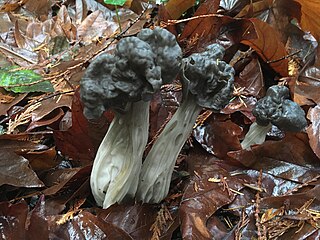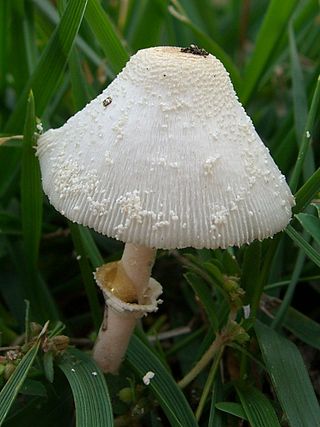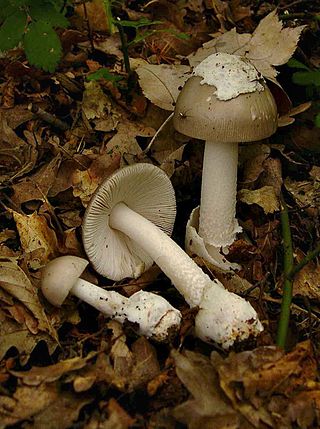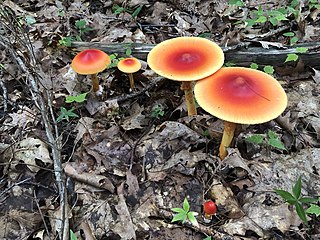
Agaricus bisporus, commonly known as the cultivated mushroom, is a basidiomycete mushroom native to grasslands in Eurasia and North America. It has two color states while immature – white and brown – both of which have various names, with additional names for the mature state, including portobello.

Amanita cokeri, commonly known as Coker's amanita and solitary lepidella, is a poisonous mushroom in the family Amanitaceae. First described as Lepidella cokeri in 1928, it was transferred to the genus Amanita in 1940.

Helvella lacunosa, known as the slate grey saddle or fluted black elfin saddle in North America, simply as the elfin saddle in Britain, is an ascomycete fungus of the family Helvellaceae. It is one of the most common species in the genus Helvella. The mushroom is readily identified by its irregularly shaped grey cap, fluted stem, and fuzzy undersurfaces. It is usually found in Eastern North America and in Europe, near deciduous and coniferous trees in summer and autumn.

Lactifluus volemus, formerly known as Lactarius volemus, and commonly known as the weeping milk cap or bradley, is a species of fungus in the family Russulaceae. It is widely distributed in the northern hemisphere, in temperate regions of Europe, North America and Asia as well as some subtropical and tropical regions of Central America and Asia. A mycorrhizal fungus, its fruit bodies grow on the ground at the base of various species of trees from summer to autumn, either individually or in groups. It is valued as an edible mushroom, and is sold in markets in Asia. Several other Lactifluus mushrooms resemble L. volemus, such as the closely related edible species L. corrugis, but these can be distinguished by differences in distribution, visible morphology, and microscopic characteristics. L. volemus produces a white spore print and has roughly spherical spores about 7–8 micrometres in diameter.

Leucocoprinus cepistipes, is a species of fungus in the family Agaricaceae. It is typically found on wood debris, such as wood chips but may also grow in potted plants or greenhouses. Typical characteristics include a fine-scaled bell-shaped cap, a partial veil, and a tendency to bruise a yellow to brown when handled.

Tricholoma terreum, commonly known as the grey knight or dirty tricholoma, is a grey-capped mushroom of the large genus Tricholoma. It is found in coniferous woodlands in Europe, and has also been encountered under introduced pine trees in Australia and New Zealand. It is regarded as edible. A 2014 article speculated that it may be poisonous, but Sitta et al. in 2016 published in the same journal a counter article demonstrating the unfounded nature of such speculation.

Amanita vaginata, commonly known as the grisette or the grisette amanita, is an edible mushroom in the fungus family Amanitaceae. The cap is gray or brownish, 5 to 10 centimetres in diameter, and has furrows around the edge that duplicate the gill pattern underneath. Unlike many other Amanita mushrooms, A. vaginata lacks a ring on the stem.

Amanita daucipes is a species of fungus in the family Amanitaceae of the mushroom order Agaricales. Found exclusively in North America, the mushroom may be recognized in the field by the medium to large white caps with pale orange tints, and the dense covering of pale orange or reddish-brown powdery conical warts on the cap surface. The mushroom also has a characteristic large bulb at the base of its stem with a blunt short rooting base, whose shape is suggestive of the common names carrot-footed lepidella, carrot-foot amanita, or turnip-foot amanita. The mushroom has a strong odor that has been described variously as "sweet and nauseous", or compared to an old ham bone, or soap. Edibility is unknown for the species, but consumption is generally not recommended due its position in the Amanita subgroup Lepidella, which contains some poisonous members.

Amanita australis is a species of fungus in the family Amanitaceae. It produces small- to medium-sized fruit bodies, with brown caps up to 9 centimetres in diameter covered with pyramidal warts. The gills on the underside of the cap are white, closely crowded together, and free from attachment to the stem. The stem, up to 9 cm long, has a ring and a bulbous base. The mushroom may be confused with another endemic New Zealand species, A. nothofagi, but can be distinguished by differences in microscopic characteristics.

Amanita jacksonii, also known as Jackson's slender amanita, American Slender Caesar, and Eastern Caesar's Amanita, is a North American species of fungus in the family Amanitaceae. It is a reddish-orange colored mushroom species which can be identified by its yellow gills, large, white, sacklike volva.

Amanita atkinsoniana, also known as the Atkinson's amanita, is a species of fungus in the family Amanitaceae. The fruit body is white to brownish, with caps up to 12.5 centimetres in diameter, and stems up to 20 cm long. The surface of the cap is covered with brownish conical warts.

Amanita ravenelii, commonly known as the pinecone lepidella, is a species of fungus in the family Amanitaceae. The whitish fruit bodies are medium to large, with caps up to 17 centimetres wide, and stems up to 25 cm (10 in) long. The cap surface has large warts and the stem has a scaly, bulbous base. The mushrooms have a unique chlorine like odor.

Amanita crocea, the saffron ringless amanita, is a species of Amanita widely distributed in Europe. It is not recommended for consumption due to its similarity to poisonous species of the genus.

Amanita ochrophylla is a fungus of the family Amanitaceae native to southeastern Australia. Its large and distinctive buff fruit bodies are common after rainfall.

Amanita ananiceps is a species of agaric fungus in the family Amanitaceae native to Australia.

Hygrophorus russula, commonly known as the pinkmottle woodwax, false russula, or russula-like waxy cap, is a fungus native to North America and Europe.

Macrocybe crassa is a species of fungus that is native to Sri Lanka, India (Kerala), Thailand and Malaysia. The large pale cream to brownish mushrooms can weigh up to 1.25 kg and have 40 cm diameter caps. They are widely consumed and highly regarded.
Macrocybe gigantea is a species of mushroom that is native to India, Pakistan, and Nepal.
Austroboletus olivaceoglutinosus is a species of bolete fungus found in Sikkim in northeast India. It is so named for its sticky olive-green cap.

Termitomyces eurrhizus species of agaric fungus in the family Lyophyllaceae native to Pakistan, India, Sri Lanka, Burma, southwestern China and Malaysia. The fungus has a symbiotic relationship with termites, its mushrooms growing out of mounds after periods of rainfall. It is eaten in Malaysia and the Indian subcontinent.


















